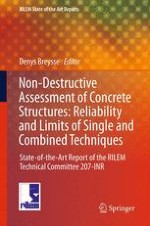This book gives information on non destructive techniques for assessment of concrete structures. It synthesizes the best of international knowledge about what techniques can be used for assessing material properties (strength) and structural properties (geometry, defects...). It describes how the techniques can be used so as to answer a series of usual questions, highlighting their capabilities and limits, and providing advices for a better use of techniques. It also focuses on possible combinations of techniques so as to improve the assessment. It is based on many illustrative examples and give in each case references to standards and guidelines.
